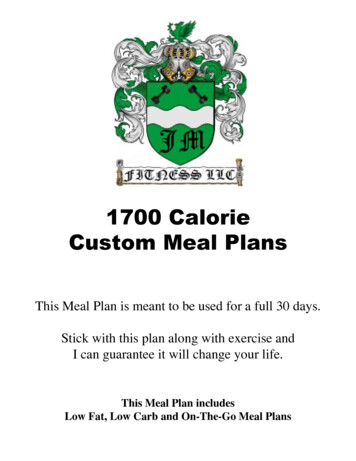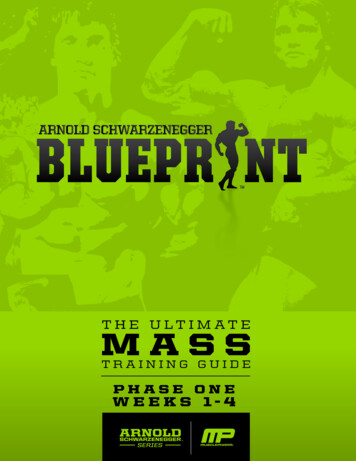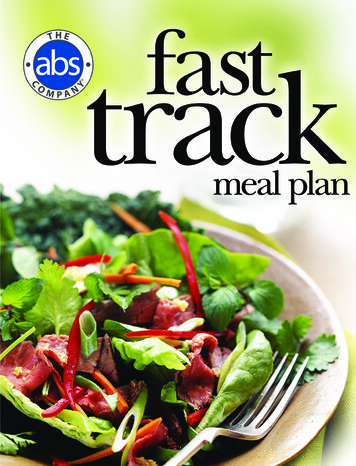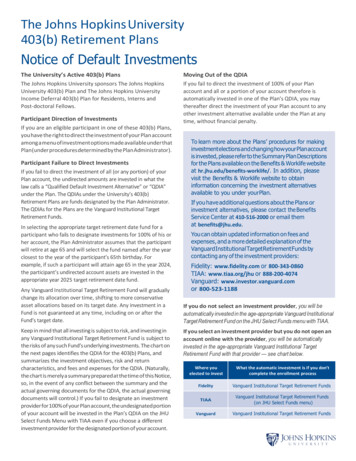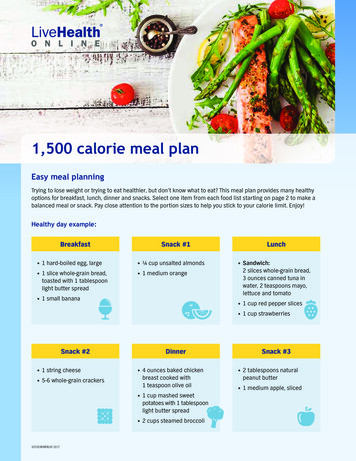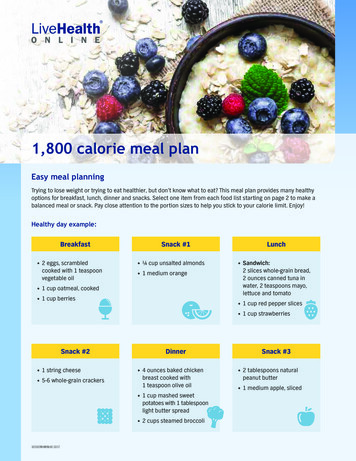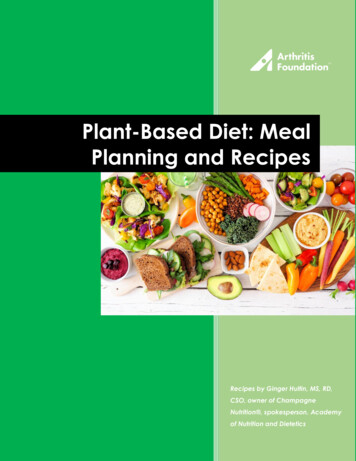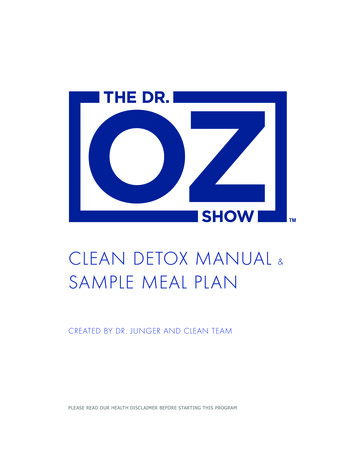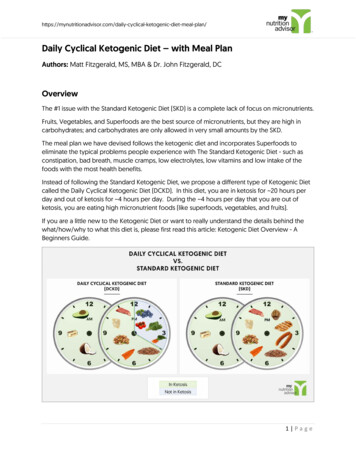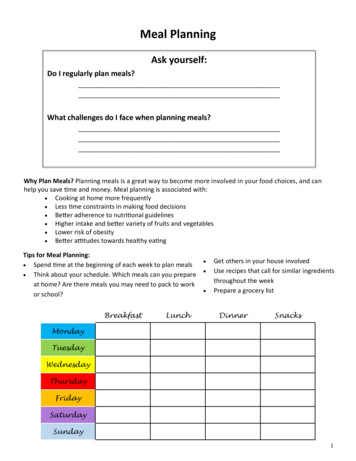
Transcription
Meal PlanningAsk yourself:Do I regularly plan meals?What challenges do I face when planning meals?Why Plan Meals? Planning meals is a great way to become more involved in your food choices, and canhelp you save time and money. Meal planning is associated with: Cooking at home more frequently Less time constraints in making food decisions Better adherence to nutritional guidelines Higher intake and better variety of fruits and vegetables Lower risk of obesity Better attitudes towards healthy eatingTips for Meal Planning: Spend time at the beginning of each week to plan meals Think about your schedule. Which meals can you prepareat home? Are there meals you may need to pack to workor school?BreakfastLunch Get others in your house involvedUse recipes that call for similar ingredientsthroughout the weekPrepare a grocery aySaturdaySunday1
Grocery Shopping Tips Always make a grocery list. Keep list in a central location, and update as you run out of items Check pantry before adding to the list Organize your list by food group or grocery store layoutStick to your list. Avoid shopping every aisle.Never go to the grocery store hungryRead food labelsBudget Friendly Grocery Shopping Tips Use coupons and rewards cardsDownload grocery store appBuy store brandsCompare unit pricesBuy on sale and in bulkBe careful not to buy more fresh produce than you will useAlways check “sell by” and “best used by” datesFarmers’ MarketsTips for Reading Nutrition Labels: Check serving size firstThe % Daily Values (%DV) are based on the Daily Valuerecommendations for key nutrients. A quick reference: 5% DV or less is low for a nutrient 20% DV or more is high for a nutrientChoose foods with 15 g total sugars per serving 5% DV for added sugarsTips for Meal Prep Consider setting aside time at the beginning of theweek to prepare mealsSlice fruits and vegetables ahead of timeBatch cookingCrock-pot / slow-cooker recipesMulti-cookerPack lunches and snacks the night before to save timeon busy morningsInvest in reusable containersPut away leftovers immediately to save time, money,and caloriesFreeze extra portions2
Ask yourself:What does a balanced meal look like?Fruits Aim for 1 1/2—2 cups per dayShopping Tips: Fresh fruits in produce section—look for those in season for best taste and prices Frozen fruits without added sugars If choosing canned fruits, purchase in “100% juice” instead of syrupTips to increase fruit intake: Keep “in sight” in a bowl on tables and countertops for easy snacking Prepare ahead for on-the-go snacks (slice, use bags/reusable containers, whole fruits) Get creative! Add fruits to cereals, smoothies (1/2 cup), salads, meat dishes, grill at barbequemeals or have for dessertVegetables Aim for 2-3 cups non-starchy vegetables per dayMake 1/2 of your plate vegetablesShopping Tips: Fresh vegetables in produce section —look for those in season for best taste and prices Consider prepared vegetables (bagged lettuce, cut-up celery, salad bar) Frozen vegetables without added sauces or gravies If buying canned vegetables, read labels and choose “reduced sodium”, “low sodium”, or “nosalt added”Tips to increase vegetable intake: Prepare ahead Pre-slice raw vegetables at the beginning of the week for easy snacking (celery, cherrytomatoes, carrots, peppers, radishes, snap peas, cucumbers) Keep salad greens on hand for a low-prep side or meal Batch cook vegetables to last several meals (beets, squash, turnips, parsnips, eggplant,brussel sprouts) Try cooking vegetables in new ways Roasted, steamed, sautéed, riced, spiralized Use new flavors – lemon, garlic, ginger, or your favorite herbs & spices Get creative! Add vegetables to your favorite recipes. Can add vegetables to stir-fry, casseroles, omelets, soups and stews, pasta dishes, pizzas,baked goods, and can grill at barbeque meals Try adding peppers, onions, spinach, and mushrooms to your morning omelet Opt for more veggies than high-fat meats and cheeses on a homemade pizza Try grilled veggie kabobs at your next barbeque (zucchini, squash, cherry tomatoes)3
4
5
Grains and Starches Limit portions of grains and starches to 1/4 plate or 1/2 cupRice, pasta, breads, and starchy vegetables such as potatoes, corn, peasChoose whole grains more often Switch to 100% whole grain bread, bread products, and crackers Try whole grain cereal or oatmeal (overnight oats) Popcorn without added salt or butter Try brown rice or 100% whole grain pasta Try mixing half and half to start Add quinoa, brown rice, or barley to soups/stews, stuffed peppers,salads, and other mixed dishes Use whole wheat flour when bakingProtein Choose protein foods at every meal and snack to stay full.Tips for healthy proteins:1. Choose lean meats and poultry Lean beef cuts include round, roast, sirloin, chuck shoulder Choose lean ground beef—try “90/10” instead of “80/20” Choose lean pork—tenderloin, center loin Skinless chicken breasts Lean deli meats2. Choose fish at least twice per week Grill or bake salmon, trout, or other favorite fish Purchase tuna in water—top salads, crackers, or sandwiches3. Vary meals with plant-based proteins Make chili or soups with beans, lentils or split peas Add black beans to salads or make enchiladas with beans instead of meat Hummus, veggie burgers, falafel, tofu6
Dairy Good source of protein, calcium and vitamin DChoose “light,” “low-fat,” or “fat free” dairy products Skim or 1% milk Cheese Greek yogurt, yogurt, cottage cheese Purchase individual containers for easy snacks Avoid high sugar varieties such as “fruit on the bottom”Limit high fat dairy foods Limit cream and whole milk in coffee and other beverages Cream-based soups, sauces, and desserts High fat cheesesDo you have trouble tolerating lactose? Try lactose-free dairy milk (i.e. Fairlife, Lactaid)Greek yogurt generally has less lactose than regular yogurtHard cheeses have less lactose than soft cheesesConsider taking a lactase enzymeIf choosing dairy milk alternatives, remember to chooseunsweetened and check protein contentLet’s Plan a Meal:7
More Tips for Meal Planning: Eat small, frequent meals and snacks to help stabilize blood sugars, reduce cravings, stay full, and reduce overeating Don’t let yourself get too hungry before you eat Have breakfast every morning, even if it’s something small Pack healthy meals and snacks to work/school and on-the-goQuick breakfast ideas-Oatmeal or whole grain cereal with skim or 1% milk Make ahead tip: try overnight oats by soaking ½ cup oats in milk overnight If using instant oatmeal, choose “no sugar added”-Greek yogurt with berries-Cottage cheese with fruit-Banana with 1 Tbsp. peanut butter-1-2 hard-boiled eggs whole grain English muffin or bagel thin Make ahead tip: boil eggs at the beginning of the week-Protein shake or protein bar-If you have more time: Veggie omelet with onions, mushrooms, spinach, tomatoes 1 slice whole grain toast Make a fruit salad with low-fat yogurt and mintPack to Work and SchoolEasy-to-grab portion controlled foods-Individual Greek yogurt or cottage cheese-Individual packs of nuts (i.e. 100 calorie packs)-Whole fruit (Oranges, bananas, apples, pears)-Instant oatmeal packets (“no sugar added”)-Low sodium soups-Portion-controlled meals (i.e. Lean Cuisine,Smart Ones, Healthy Choice, Kashi)-Tuna packets-Protein packs (i.e. P3)-Protein shake or protein barPrepare Ahead-Sliced fruits and vegetables-Leftovers from the night before-Salads with protein-Leafy greens, sliced fruits and vegetables-Leftover grilled chicken, salmon, tuna packet, hardboiled eggs, chickpeas or black beans-Light dressing or oil and vinegar-Homemade Lunchables-Lean deli meats, low-fat cheese, crackers-Sandwiches on whole grain bread, bagel thin, pita, ortortilla-Tuna in water mixed with light mayo and relish-Lean deli meats and low-fat cheese-Leftover meats and vegetables-Veggies and hummus-Mashed beans, vegetables, avocado slices, low-fatcheese, cilantro, lime juice8
Building A Healthy Snack: Snacks can provide energy between meals and keep you from over-eating later in the day. Snack only when you’re hungry. Avoid grazing and mindless eating, especially when you are feelingbored or stressed. Try to incorporate protein and/or fiber to help you stay full. Keep snacks 200 calories or less. Pay attention to portion sizes. Eating more frequently means less at each snack. Consider pre-measured snacks If buying in bulk, portion foods out in small containers as soon as you bring it in the house. Storeexcess in a place that is not easy to get to.Healthy Snack Ideas( 200 calories or less)-1 Tbsp. peanut butter 1 apple, banana or celery-Sliced vegetables 2 Tbsp. low-fat ranch, lightdressing, or hummus-Try cucumber, cherry tomatoes, carrots, celery,radishes, snap peas, bell peppers-1 cup sliced fruit with 1 hard-boiled egg-1 cup edamame-6 whole wheat crackers 1 slice low-fat cheese-1 (6”) tortilla with ¼ cup black beans 2 Tbsp. salsa-1 cup tomato soup 5 whole grain crackers-3 cups popcorn 3 Tbsp. grated Parmesan cheese-1 small baked potato salsa 1 oz. low-fat cheese-Mini sandwich – whole grain dinner roll with 1 slicelean deli meat 1 slice low-fat cheese mustard-Protein shake or protein bar-100 calorie pack 1 piece of fruitEnjoy!AvoidChoose beverages with 10 calories per servingCarbonation, Caffeine, Sugar, AlcoholWaterSparkling waterFruit-infused water*try citrus (lemon, lime, orange), berries, cucumber, mint, ginger, rosemaryJuiceDecaf teaSweetened teas / lemonadesDecaf coffeeSweetened and caffeinated coffeesBeverages sweetened with artificial or nonnutritive sweetenersSoda, Energy Drinks9
8 More Tips for Meal Planning: Eat small, frequent meals and snacks to help stabilize blood sugars, reduce cravings, stay full, and re- duce overeating Don’t let yourself get too hungry before you eat Have breakfast every morning, even if it’s something small Pack healthy meals and snacks to work/school and on-the-go Quick breakfast ideas

